#solomon grundy 2009
Photo


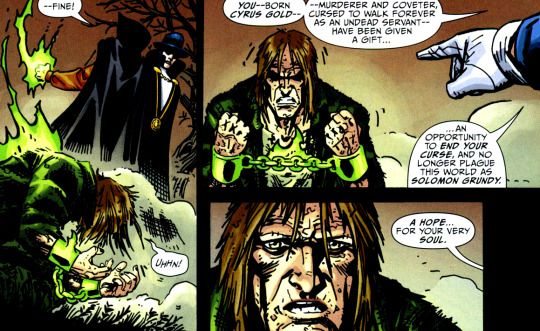






A chance? He just killed another man! And he has countless other lives to answer for!
Alan Scott in Solomon Grundy (2009) #1
#solomon grundy 2009#solomon grundy#cyrus gold#alan scott#green lantern#phantom stranger#the phantom stranger#scott kolins#dc#dc comics#dcedit#comicedit#comicsedit#u can reblog#scott gives alan THE funniest expressions ever god fucking bless#almost done with uploading panels from my latest mart acquisitions! but god i do love this absolutely hilarious book#grundy brings out in alan exactly what jared does which is why this is one of the funniest dynamics possible when alans tasked w keeping him#alive and fails literally one hour later
8 notes
·
View notes
Photo
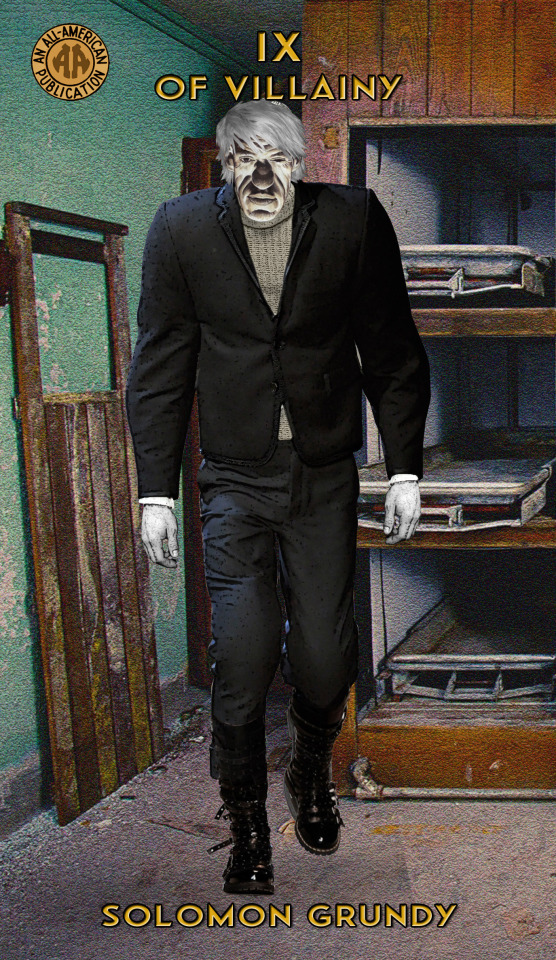
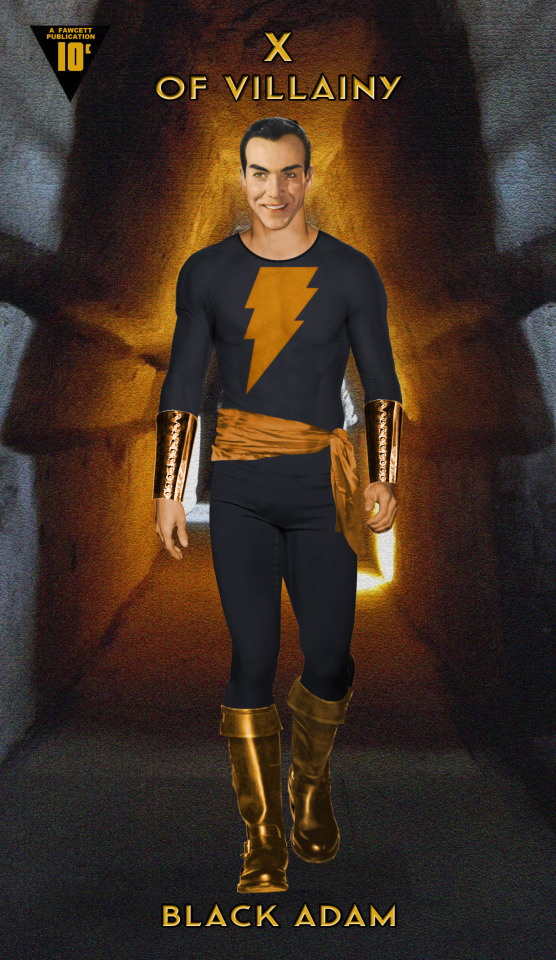
HOUSE OF VILLAINY
SOLOMON GRUNDY
Created By: Alfred Bester & Paul Reinman
1st Appearance: All-American #61 - Oct 1944
Publisher: All-American Comics
Team: Villain
Actor: Rondo Hatton (1894 - 1946)
BLACK ADAM
Created By: Otto Binder & C.C. Beck
1st Appearance: Marvel Family #1 - Dec 1945
Publisher: Fawcett Comics
Team: Villain
Actor: Ricardo Montalban (1920 - 2009)
2 notes
·
View notes
Text
Concealment of the Jewish Peoples (The Medical Traditions)
Implements:
Gotham City writing game, limited review, first incarnation; given a simplified four point non-modifiable dice system for compared rolls, with a tracking system and a dodging margin increase system, to dis-favor mathematics of division per tracked unit.
Megaman MUSH applications box, privately held, labeled under “David Charlebois”, body of work from 2002 to 2010, firing pin date in 2009 (placement of psychiatric amplifier in common view, psychology exercise of therapy to remove triggers therapy protocols with ‘power words’ banned for aggressor’s rights over victims).
Mathematical Design:
Non-integral imaginary numbers: Crossed origins, of physical appearances, of two roles, Ivan Tomasic, “Bullock”, and David Charlebois, “Scarecrow”, with parents backgrounds stated to match the characters given in parent.
Keypoint Switch Change: Two-Face, and Solomon Grundy, switched per necessary weight class, the 1-2 on Ecce Homo, the Italian Mussolinist system, however given proper fitting form, hence the siding with Jewish villainy, through Gentiles.
Euripedean Theater: The choice of company, between hero and nemesis, Karate Kid through Gaijin, and Good Will Hunting through Dr. Strangelove: Or How I Learned To Stop Worrying and Love the Bomb. “Batman” and “Joker”, chained consequence of siding with Batman, as a homosexual choice, but only in dormitory, barracks, or police hall, or training academy of military through various services; hence Batman, will always select the origin scene of Joker, Jerome Valeska; which is the actual soldier, hunting Batman, the enemy, placed as Jewish within German anti-Semitism, prostitution compact.
Love Interests: Female hero, female villain, crossed, with proper race as hero, improper race as villain, shifted first in writing, then in equivalent, with series editor, placed opposite female nemesis, “Barbara McKean”, MI-6 veteran by family Cherna Gast, the sabotage of the Ku Klux Klan into “Birth of the Nation”, the frame placement of Commission Gordon, castrated military officer cop, and the split between “Catwoman” and “Firefly”, Firefly with the wrong background, and Catwoman with the wrong physical scarification
Penguin and Riddler: Strip of “Penguin”, into Woody Allen but as a psychiatrist, his films Jewish Mafia references per film at present incarnation, through turning the CIA hound’s men, the gay media advisors, straight, removing the CIA and MI-6 cartoon power (Fox, Comedy Central, Toonami, Adult Swim, NBC, ABC, TGIF). “Riddler”, placed as a police officer, reverse of background, common citizen becoming police informant, hence writers are removed from television and cinema programs, featuring police, military, or espionage advisors.
0 notes
Text
Character List + Rules (Revised)
“It’s not a crime to love what you cannot explain.”
- Klaus Michaelson, The Vampire Diaries

Contents:
o Creepypastas
o Disney Villains
o Gotham Villains
o Miscellaneous Villains
o Slasher’s / Horror Villains
~~~
Key: So this should let you know which asks I would answer first! XD
(Priority No. 1 For me) Blue- Characters I really really want to write for more often and explore.
(Priority No. 2 For me) Green- Characters I always enjoy talking about/writing for.
(Priority No. 3 For me) Orange- Basically blue except a little less.
Black: Everyone else. I love them all but Blue, Green and Orange are my favourites ^^
Creepypasta

BEN Drowned
Bloody Painter / Helen Otis
Candy Cane
Candy Pop
Clockwork / Natalie Ouellette
Dark Link
Eyeless Jack
Grinny Cat
Hobo Heart
Hoodie / Brian
Jane the Killer / Jane Richardson
Jason the Toymaker
Jeff the Killer / Jeffry Woods
Kagekao
Laughing Jack
Laughing Jill
Masky / Tim
Nathan the Nobody / Nathan Lux
Nina the Killer / Nina Hopkins
Nurse Ann / Ann Lusen Mia
Offenderman
Puppeteer / Jonathan Blake
Sally Williams
Seadeater
Slenderman
Smile Dog
Sonic. Exe
Splenderman
Ticci Toby / Toby Erin Rogers
Trenderman
Zalgo
Disney and Dreamworks Villains

Alameda Slim || Home On The Range (2004)
Bill Cipher || Gravity Falls (2012)
Captain James Bartholomew Hook || Peter Pan (1953), Return To Neverland (2002)
Clayton || Tarzan (1999)
Charles F. Muntz || Up (2009)
Chick Hicks || Cars (2006)
Cruella DeVill || 101 Dalmatians (1961)
Don Karnage || Ducktales (2017)
Dr Facilier || The Princess And The Frog (2009)
Emperor Zurg || Toy Story Franchise (1995-2019)
Evil Queen Grimhilde || Snow White (1937)
Gaston || Beauty And The Beast (1991 or 2017)
Goob || Meet The Robinsons (2007)
Governor Ratcliff || Pocahontas (1993)
Hades || Hercules (1997)
Hans || Frozen (2013)
Henry J. Waternoose || Monsters Inc (2001)
Horned King || The Black Cauldron (1985)
Hopper || A Bug’s Life (1998)
Jafar || Aladdin (1992)
Judge Claude Frollo || The Hunchback Of Notre Dame (1996)
Judge Doom || Who Framed Roger Rabbit? (1988)
Lady Tremaine || Cinderella (1950), Cinderella II: Dreams Come True (2002), Cinderella III: A Twist in Time (2007)
Long John Silver || Treasure Planet (2002)
Lots-o-Huggin’ Bear || Toy Story 3 (2010)
Lyle Rourke || Atlantis: The Lost Empire (2001)
Maleficent || Sleeping Beauty (1959)
Mother Gothel || Tangled (2010)
Negaduck / Jim Starling || Ducktales (2017)
Oogie Boogie || The Nightmare Before Christmas (1993)
Prince John || Robin Hood (1973)
Professor Ratigan || The Great House Detective (1986)
Queen Narissa || Enchanted (2007)
Queen of Hearts || Alice In Wonderland (1951 and 2010), Through The Looking Glass (2016)
Randall Boggs || Monster’s Inc (2001), Monster’s University (2013)
Scar || The Lion King (1994)
Shan Yu || Mulan (1998)
Shere Khan || The Jungle Book (1967 or 2016), The Jungle Book 2 (2003)
Stabbington Brothers (Sideburns and/or Patchy XD) || Tangled (2010)
Steelbeak || Ducktales (2017)
Sykes || Oliver & Company (1988)
Syndrome || Incredibles (2004)
Toon Patrol || Who Framed Roger Rabbit? (1988)
- Greasy
- Psycho
- Smartass
- Stupid
- Wheezy
Turbo/King Candy || Wreck It Ralph (2012)
Ursula || The Little Mermaid (1989)
Yzma || The Emperors New Groove (2000), Kronk’s New Groove (2005)
Gotham Villains (2014-2019)

Barbara Kean
Butch Gilzean / Cyrus Gold / Solomon Grundy
Headhunter / Wendell
Jerome Valeska
Mad Hatter / Jervis Tetch
Mr Freeze / Victor Fries
Penguin / Oswald Cobblepot
Professor Pyg / Lazlo Valentin
Riddler / Edward Nygma
Scarecrow / Jonathon Crane
Tabitha Galavan
Victor Zsasz
Miscellaneous / Anti-Hero’s

Al Capone || Night at the Museum: Battle Of The Smithsonian (2009)
(Dark) Alaric Saltzman || The Vampire Diaries (Season 3- 2012)
Alex Drake || Pretty Little Liars (2010-2017)
Beetlejuice || Beetlejuice (1988)
Black Hat || Villainous (2017)
Captain James Bartholomew Hook || Peter Pan (2003)
Catherine De Medici || Reign (2013-2017)
Cecil / CJ Fredericks || Night At The Museum (2006)
Classic Heavy / Cheavy || Team Fortress 2 (2011)
Charlotte Dilaurentis / Cece Drake || Pretty Little Liars (2010-2017)
Chris McLean || Total Drama (2005)
Damien Dalgaard || Gossip Girl (2007-2012)
Danny / Danial Dickens || Angels of Death (2018)
Detective Darren Wilden || Pretty Little Liars (2010-2017)
Deucalion || Teen Wolf (2011-2017)
Diana Payne || Gossip Girl (2007-2012)
Don Falcone || The Batman (2021)
Eddie / Edward Mason || Angels of Death (2018)
Eric || Divergent and Insurgent (2014-2015)
Eris || Sinbad: Legend of the Seven Sea’s (2003)
Gilderoy Lockheart || Harry Potter and the Chamber of Secrets (2002)
Georgina Sparks || Gossip Girl (2007-2012)
Heather || Total Drama Island (2005)
Ian Esko || Zombie Strippers (2008)
Ivan The Terrible || Night At The Museum: Battle Of The Smithsonian (2009)
Jack Bass || Gossip Girl (2007-2012)
Jo || Total Drama; Revenge of The Island and All Stars (2012-2014)
Kahmunrah || Night At The Museum: Battle Of The Smithsonian (2009)
Katerina Petrova / Katherine Pierce || The Vampire Diaries (2009-2017)
Kurt Kelly || Heathers
Lucius Malfoy || Harry Potter franchise (2001-2011)
Mal (Mike) || Total Drama All Stars (2014)
Merle Dixon || The Walking Death (2010)
Mona Vanderwaal || Pretty Little Liars (2010-2017)
Napoleon Bonaparte || Night At The Museum: Battle Of The Smithsonian (2009)
Narcissa Malfoy || Harry Potter franchise (2001-2011)
Owen || The Walking Dead (2010)
Peter Hale || Teen Wolf (2011-2017) *Keep in mind I’m only on Season 5*
Peter Hayes || Divergent, Insurgent, Allegiant (2014-2016)
Ram Sweeney || Heathers
Rand Ridley || Inside Job (2021)
Rothbart || The Swan Princess (1994)
Rustyrose || Fairy Tail (2011-2016)
Severus Snape || Harry Potter franchise (2001-2011)
Scott || Total Drama; Revenge of The Island and All Stars (2012-2014)
Spike / William Pratt || Buffy the Vampire Slayer (1997-2002)
Stephene Narcisse || Reign (2013-2017)
SQUIP / Super Quantum Unit Intel Processor || Be More Chill (2015)
Zancrow || Fairy Tail (2011-2016)
Ultear Milkovich || Fairy Tail (2011-2016)
Once Upon A Time Villains

The Blind Witch
Cruella De Vil
Evil Queen / Regina Mills
Hades
Maleficent
Prince James / James Nolan
Sir Gaston LeGume
Sydney Glass / Magic Mirror / Genie of Agrabah
Ursula
The Wicked Witch / Zelena Mills
Slashers / Horror Villains

Animal The Cannibal / Jeffrey Ramses || The Funhouse Massacre (2015)
Baby Firefly || The Devil’s Rejects (2003)
Billy Loomis || Scream (1996)
Bo Sinclair || House of Wax (2005)
Bubba Sawyer || The Texas Chainsaw Massacre franchise (1974-1986)
Candyman / Daniel Robitaille || Candyman (1992)
Captain Spaulding || The Devil’s Rejects (2003)
Carrie White || Carrie (1976)
Chucky / Charles Lee Ray || Childs Play franchise (1988-2017)
Chop Top Sawyer || The Texas Chainsaw Massacre 2 (1986)
Drayton Sawyer || The Texas Chainsaw Massacre franchise (1974-1986)
Debbie Loomis || Scream 2 (1997)
Dr Suave / Bradford Young || The Funhouse Massacre (2015)
Freddy Krueger || A Nightmare on Elm Street franchise (1984-2003)
Granny Boone || 2001 Maniacs (2005)
Harper Alexander || 2001 Maniacs (2005)
Inkubus || Inkubus (2011)
Jason Voorhees || Friday the 13th franchise (1980-2003)
Jedidiah Sawyer || Texas Chainsaw 3D (2013)
Jennifer Check || Jennifer’s Body (2009)
Jerry Dandridge || Fright Night (1985)
Jill Roberts || Scream 4 (2011)
Kieran Wilcox || MTV Scream (2015)
Leslie Vernon || Behind The Mask: Rise of Leslie Vernon(2006)
Lester Sinclair || House of Wax (2005)
Luda Mae Hewitt || The Texas Chainsaw Massacre (2003), The Texas Chainsaw Massacre: The Beginning (2006) (REMAKE #1)
Max Grief || Roadman (2010)
Mayor Buckman || 2001 Maniacs (2005)
Mental Manny / Manuel Dyer || The Funhouse Massacre (2015)
Michael Myers || Halloween franchise (2007-2009) (REMAKE)
Mickey Altieri || Scream 2 (1997)
Midnight Man || The Midnight Man (2016)
Otis B Driftwood || The Devil’s Rejects (2003)
Pamela Voorhees || Friday the 13th franchise (1980-2003)
Patrick Bateman || American Psycho (2000)
Pennywise || It (1990)
Pennywise || It (2017)
Piper Shaw || MTV Scream (2015)
Rocco The Clown || The Funhouse Massacre (2015)
Roman Bridges || Scream 3 (2000)
Sheriff Hoyt / Charlie Hewitt || The Texas Chainsaw Massacre (2003), The Texas Chainsaw Massacre: The Beginning (2006)
Stuart Lloyd || The Last Showing (2014)
Stu Macher || Scream (1996)
The Clown / Jeffry Hawk / Kenneth Chase || Dead By Daylight
The Deathslinger / Caleb Quinn || Dead By Daylight
The Djinn || Wishmaster (1997)
The Huntress / Anna || Dead By Daylight
The Man || Hush (2016)
The Taxidermist / Walter Harris || The Funhouse Massacre (2015)
Thomas Hewitt || The Texas Chainsaw Massacre (2003), The Texas Chainsaw Massacre: The Beginning (2006) (REMAKE #1)
Vincent Sinclair || House of Wax (2005)
#Character List#Horror Villains#Slashers#Misc#Misc Villains#Night At The Museum 2 Villains#Disney Villains#Creepypasta
34 notes
·
View notes
Text
I am SHAKING right now because I’ve had WAAAAAY to much coffee and
I just saw a post about Generator Rex on my dash and here’s the thing:
I had completely forgotten it existed.
I LOVED that show. It was legit one of my first real fandoms? HOW did I entirely fucking forget about it? I literally cannot even remember anything about the show right now except that I was constantly lusting over Agent Six?
And when I went back to look at my fandom timeline on my old archived tumblrs, I also was reminded that I was into Ben 10. Not quite to the degree I was into Gen Rex but enough that I remember reading obsessive!darkfic of Kevin/Gwen back on DeviantArt BEFORE Ben 10 made him into a good guy in Ben Ten: Alien Force.
(Yes, I have apparently always liked creepy ships--even in early adolescence.)
Ben 10 started when I was pretty young, to the point I was watching with intrigue whenever I saw it on cartoon network but not YET able to keep track of a schedule well enough to not miss episodes.
But by the time Ben 10 Alien Force hit?
Oh FUCK yeah--my ability to actually follow fandoms developed!
So my fandom timeline looks like this:
Fanfic.net and DeviantArt accounts started in 2007. I was liking futzing around on these sites a few weeks/months before breaking down and making accounts. I distinctly remember Quizilla being somewhere in there as well. This was right as I ended middle school/started high school and really started getting into fandom as a regular hobby. Main fandoms were Harry Potter, Naruto, Bleach.
I discovered Livejournal a year or two later and sadly made an account in 2009 right as the site was exploding but I enjoyed the short time I spent there. I was introduced to the Star Trek reboot movies, GenRex, and Ben 10 Alien Force during this time. I futzed around in communities for those fandoms (and the aforementioned fandoms) for a year before I gleaned everyone was mid-exodus and followed to tumblr. I made my first tumblr blog in summer of 2010 but didn’t really start using it regularly until 2011.
I was immediately sucked into the SPN fandom! The pretty blue eyed angel standing in a shower of sparks won my heart and I’ve been in hell ever since. (Even when you leave the SPN fandom you never really leave.)
Simultaneously, Young Justice started and I enthusiastically jumped in--unearthing my early childhood love of Batman: TAS, Justice League/Unlimited, Batman Beyond, and Teen Titans in the process. I proceeded to rewatch all of those shows. When rewatching JLU I distinctly remember flashing back to the memory of me sobbing over both Solomon Grundy and the Flash nearly/outright dying in their respective JLU episodes when I was roughly eight years old. This is the first time I can remember contemplating death and experiencing empathy for a fictional character. I’m still wrecked if I watch those episodes! (Really DCAU as a whole is pretty heartwrenching and will wreck my ass.)
Also around that time I also was introduced to Ao3 and spent many months just casually reading fic there before I finally wised up and created an account in the summer of 2011.
Iron Man and Thor were my gateway to the greater MCU. I experienced peak tumblr from 2012-2015. Superwholock was everywhere and you can hate it as much as you want but it got me into Doctor Who and I am so, so fucking thankful for all of those fandoms. They were so sincere and enthusiastic and wanting to see the next episode/season and liveblog it along side everyone else were sometimes the only reason teenage me had for not wanting to kill herself.
I made it through the worst of it in my personal life. College happened. I stayed on tumblr even when the Purge happened in 2018. I mourn the loss of p0rn and had to fan myself when I rediscovered the old sideblog I made just for hardcore lemony fanart that I forgot existed until I started making this post.
I’m an adult in a much better place. I’m anxious sometimes about what will happen next in fandom and sometimes nostalgia for what came before makes me feel gloomy/overly pessimistic--but regardless of what comes next, in the end I believe it will be an adventure and full of exploration! I will adapt and I will thrive and I will squee along side everyone else as new and wonderous fandoms emerge!
6 notes
·
View notes
Link
ROBERT SIKORYAK’S REMARKABLE SKILL often goes unappreciated because of its subtlety. His works are acts of cultural appropriation that deftly mine our comic book memories, filtering history and literature through our understanding of comic book history. His art enables our collective, illustrated past to mediate the present. What do we learn, for example, about the culture that produced iconic figures such as Mary Worth and Rex Morgan, M.D., when these two characters reappear as Shakespeare’s Macbeth and Lady Macbeth? If we, as a culture, haven’t yet come to terms with the extent of the sorrows expressed in Charles Schulz’s many decades of pathos-laden Peanuts strips, Sikoryak reassembles the ideological pieces for us, rendering Kafka’s The Metamorphosis in Schulz’s style and retitling it: “Good ol’ Gregor Brown.” Both of these strips, like all of Sikoryak’s work, demonstrate his keen eye and extraordinary finesse.
Sikoryak, born in 1964, generally signs his name “R. Sikoryak.” He has drawn cover art for The New Yorker, LA Weekly, and The Nation. His work has been featured in Wired magazine as well as in the groundbreaking publication Raw, where he worked together with Art Spiegelman and Françoise Mouly shortly after graduating from the Parsons School of Design in the late 1980s. In 2009 Sikoryak published his 64-page hardcover collection of literary works reimagined as classic comics Masterpiece Comics, and his Terms and Conditions: The Graphic Novel (2017) — an inspired take on the unreasonable language of user license agreements — was reviewed six months ago in LARB. He currently lives in New York and teaches illustration at Parsons.
I interviewed Sikoryak about Masterpiece Comics and about his recently published book, The Unquotable Trump. The Unquotable Trump is a collection of iconic comic book covers from many decades that have been remastered to show first Candidate Trump, and then President Trump, taking over the respective comic book’s worlds. Sikoryak’s Trump goes head-to-head with the comic world’s most iconic characters, including Neal Adams’s Superman, John Romita’s Spider-Man, and even Warren Kremer’s Richie Rich. For the book, Sikoryak relied only on direct quotes — as its cover boasts, it consists of “Trump in his very own ‘best words!’”
¤
BRAD PRAGER: On several pages of The Unquotable Trump, Trump is seen speaking even when there is no speech in the originals. For example, the cover of your book is based on a cover of the 1975 Marvel Treasury Edition featuring the Incredible Hulk. On that cover, the Hulk is silent, but your “Hulk-Trump” is uttering a number of standard Trumpisms (“Tremendous!,” “Huge!”). A similar change is noticeable on your “Nice Nurse” cover as well, which is based on an issue of Night Nurse from 1973. In the original, the Night Nurse character is actually speaking, defending her patient by saying, “To kill him — you have to shoot me first!!” In your version, we only hear from Trump, while the comic’s heroine is speechless.
As I conceived the book, I felt it was important to only go by what Trump said. The book is obviously critical of him, but within that context, yes, he’s the only one who actually gets to speak. I conceived of the book right before the election. I had seen a series of mini-comics published by someone I don’t know, a series called “Tea Party Comix” consisting of old comics in which Obama had been inserted as the villain. I came upon them through Ethan Persoff’s site, where he posts a lot of obscure comics. My approach is quite different from those. I really wanted the whole world depicted in these covers to be infected by Trump. Even the titles of the books that he’s in have been tailored to fit his perspective. Sometimes the titles are more neutral, like “Subjective Comics,” based on Detective Comics, but on other ones, like the Wonder Woman cover in which she’s not Wonder Woman, but “Nasty Woman,” Trump’s language becomes part of the world that the characters inhabit. These characters do have a voice — they have personalities, and they have humanity — but as far as this book is concerned, everything is shaped by Trump’s perspective, and he drowns out everyone else.
The cover that is most striking for me, and which is most suffused with Trump’s perspective, is Pap Comics, featuring “Archy,” which is based on an issue of Pep Comics from 1952. If you look at the original cover, Archie is as happy as can be. His face is covered in lipstick from Veronica’s kisses. In your version, he is truly miserable. Even in the book’s marketing icon, in the upper right, poor “Archy” is suddenly suffering, wondering how all this has happened. The world has been invaded, much to the chagrin of the characters we know and with whom we identify. This is Pop’s soda shop, and Trump, as Pop, is running the show. Elsewhere, of course, you have him appear as Solomon Grundy or the Red Skull.
I was always trying to find a dynamic where, if Trump wasn’t a villain, he was at least a counterpoint to the main character. He takes the place of Tubby in Little Lulu, for example. Tubby is hardly a super villain but sometimes he’s a pretty bratty kid, so there the equation sort of works.
Several of these covers read differently from the others, including two that I would describe as feminist fantasy inversions: the pairing of the Catwoman cover alongside the one George Perez did of Black Widow from a 1983 Marvel Fanfare. Those covers depict worlds in which the women are in the dominant positions. Black Widow is really carrying the day in the your version of the cover, so the book varies its perspective in that regard, even if Trump comes out on top most of the time.
Those two covers just ended up next to each other. The book is for the most part ordered chronologically. There are one or two pages where I had to shift things around. I really didn’t want to start the book with his famous quote about Mexicans, so I put his quote about building the Wall first. The two were said within the same day, so that’s not such a big change. I tried to follow the campaign’s chronology, but that led to some of the covers echoing one another in odd ways. The two you mention evolved out of the debates.
Some of the covers you’ve chosen seemed as though they were pulled directly out of my own memory bank. I remember collecting some of the Neal Adams and George Perez covers at the time of their appearances, although I had stopped collecting comics by the time the issue of 300 you cite came out in 1998. Your work mines different areas of the adult, nostalgic unconscious. Was there a principle of selection? How did you go back through your conscious and your less conscious memories, deciding what to draw?
I’m sure a lot of the choices are directly attributable to what I was collecting and what I grew up with, but I really didn’t want the book to represent only my perspective. That’s true of Terms and Conditions as well. I was trying to run the gamut of styles and to put things in the book that people who didn’t grow up in the 1970s would also remember and relate to. Because of the movie, 300 was a major pop cultural moment. It made such an impression that I thought it was worth mentioning here. I didn’t want to suggest that the concerns raised in this book apply only to, say, white men who collected comics and who are now in their 50s, but rather to suggest that these concerns apply to most everybody. Although it was easy to choose superheroes, I tried to find other ways of integrating Trump.
The cover based on an issue of Adventure Time no. 5 really torments those Adventure Time characters. On the original cover, they’re not crying. In your version, it looks as though you’ve caught them on the most miserable day they’ve ever had.
It would have been harder to do these if I had really adhered to the rules that I had first thought of when I started. But changing their expressions seemed like a minor thing.
Some of the covers resonate more strongly than others. The defeat of Superman resonates in a particular way, and here I’m thinking about the 1971 Justice League cover, the one based on the original by Neal Adams and Dick Giordano. Turning Superman into “Supersad” was an inspired take, but there’s a way in which destroying Superman is part of the fantasy that our political rhetoric plays into. It’s a horrible thing to watch, when Superman goes limp like that. Another Superman cover later that struck me similarly was the one for “World’s Failest,” based on a cover for World’s Finest on which Superman looks distraught and helpless.
That is his original pose. I didn’t have to change that one. Trump speaks a lot about good and evil and about what’s right and what’s traditional, and about what represents “our country.” The terms wouldn’t be out of place in some of the older DC comic books. But then, you see him in opposition to these characters, and I think it’s evident that he’s coming from a different place. His perspective is not the same perspective that Batman or Superman had on those issues. The gamut is pretty wide here, but the more traditional superheroes tend to resonate a lot — they’re bigger than we are.
The mediation in this project works on a number of different levels. Our collective memories are being overrun, but this is exactly what a lot of political rhetoric aspires to. Comparisons with the Red Skull plug into our worst fantasies.
There was an early Fantastic Four villain called the “Hate-Monger,” who first appeared in 1963 and was driving people crazy by instilling hate in everyone, but the cover featuring him wasn’t iconic enough. It didn’t lend itself to a specific quote, but it seemed very on the nose. Some things are built into these characters.
And a lot of what was shocking during the campaign has become normalized.
Occasionally I get feedback from someone who doesn’t know why I’m being so mean about Trump, and there are some people who don’t see him as speaking out against anyone who doesn’t have it coming. But any good villain in a movie or a comic book has a very good reason for doing what they are doing. Even Doctor Doom thinks he’s doing the right thing, so it’s really hard to know how to unpack all of this.
It’s fascinating to me how your work has so many different historical layers, which distinguishes it from a lot of similar projects. I was thinking, for example, about Alan Moore’s Supreme, which I enjoy, but in those he is mediating comics through comics. He takes the history of the traditional superhero — whether it’s Superman or Captain Marvel — and filters it through a contemporary comic book lens. That’s an interesting exercise, but what you’re doing adds an additional dimension. The Unquotable Trump works from the collective memory of our youths, as does Masterpiece Comics, in which you are mediating literature, and really history itself, through comics. That produces a kind of triangulation: the Genesis story in the Bible as seen through the figures of Blondie and Dagwood, for example, and our reception of Blondie and Dagwood entering into it as a third element. I have to ask myself, when I read Blondie, why am I still looking at this fantasy from …
… the 1930s.
Right, it’s Chic Young’s idea about what domesticity is meant to be like. Filtering the Bible through that is a fascinating exercise. As you move through literary history and the comics, how do you pair these things?
The first book I adapted was Dante’s Inferno. I think I was playing more with form than with the characterization when I combined it with Bazooka Joe bubble gum comics. I was taking the loftiest, most seriously reverential epic poem and combining it with the most disposable comic there is. But then the next one I did was “Good ol’ Gregor Brown,” and that was where I thought that there seemed to be an analogy between the personalities of Charlie Brown and Gregor Samsa. When I started putting all of it together, the parallels really came into focus. I put Kafka’s dialogue into the mouth of the Charlie Brown bug, and I saw that there was no space between these characters. I didn’t have to fudge the dialogue to make it fit Charlie Brown, other than to add a “Good Grief!” Kafka was speaking for Schulz, or vice versa, and that was really exciting. Beyond that, I felt like I was paying more and more attention to how the characters related to the stories or even maybe how the genres related.
Making Wuthering Heights into a 1950s horror comic was hardly a stretch, and I don’t know if it was enough of a stretch to get the kind of jolt that I am usually looking for. But the way that novel is generally treated and thought of is much milder than the novel actually is, so I had to think of a really brutal comic to combine the novel with. I think about how things might connect and I make notes. Sometimes nothing comes of them, but sometimes something really seems like the right idea and I pursue it. What’s fun about doing these, and what has become important sometimes, is thinking about how the stories are told. I’m currently working on a sequel to Masterpiece Comics, and one of the new stories appeared in the Graphic Canon of Children’s Literature (2014). It’s a version of Tom Sawyer in the style of one of these Family Circus maps, and it actually tells the whole story as he moves through the neighborhood, to the island, to the courthouse and then to the cave. In that case I was playing with the wholesome kids of Family Circus set against Mark Twain’s more shaded views of youth. I had been asking myself, “How can I take this structure and use it to tell the story?” So, it happens in different ways. People have suggested ideas to me for other strips, and I could see how they would work. If they don’t resonate with me I won’t do them, but it all seems valid to me, and there are many ways to approach it.
It almost gets lost that you’re also offering a literary reading of a text, whether it’s of Marlowe or Brontë or any other author. It shouldn’t go unremarked that you’re a good close reader of literature. When it comes to “Inferno Joe,” I notice that you only picked Inferno. There’s no Purgatorio or Paradiso. There’s only “Inferno Joe.”
That strip was done for Raw Magazine in 1989. I only had one page, and at that point I’d only read Inferno. I thought about going back to finish the trilogy. I like closure and I considered it, but they don’t even make Bazooka Joe comics anymore. They changed the format, which is heartbreaking to me for a couple of reasons. I don’t know if that would resonate, but I considered following Joe through the other realms. It was more a question of space. Inferno is a satisfying read on its own, and many people don’t read the other two.
Raw’s aesthetics may also have helped determine that there would be only Inferno. But in any case the journey to Hell brings out something about the strange world that these figures inhabit: Bazooka Joe himself has an eye patch, which is a difficult fate for a teenager — however that might have happened — and his friend, Mort, has this oddly placed turtleneck, which turns him into Joe’s mouthless guide through Hell.
Looking at “Blond Eve,” your take on the Genesis story — your decision to turn Mr. Dithers into God was inspired. This meddling boss is walking around ruining everything for Blondie and Dagwood’s Adam and Eve. They seemed to have it good, and then their exile becomes the world of Chic Young’s comic. You’ve given us an origin story. This could be the very first Blondie. It tells us how they got into that house in the first place. They were exiled from Heaven, and now nothing remains but our cruel laughter over their fates.
Sometimes when I do these strips I end up killing the characters. Batman only goes to jail in “Dostoyevsky Comics.” But the Blondie one was striking. I was thinking it through, and I thought, “Oh, that’s were they would end up.” It’s not the end, but the beginning.
I noticed that you drew a sendup of The Lockhorns in which Mr. Lockhorn is explaining the stakes of the Vietnam War to Mrs. Lockhorn. His particular kind of sadistic masculinity is what anyone who enjoys The Lockhorns finds funny. He’s saying to her, “If Vietnam falls, all of Asia goes red, you stupid cow.” The Lockhorns first appeared in 1968, and repositioning him in this way, within that historical moment, is right on the money.
That was a drawing I did for The Daily Show. It was a commissioned illustration for them, and I think it was in response to the Muhammad cartoons in the Danish newspaper. It was written by The Daily Show’s staff, some of whom are big comics fans. They were excited that they could get a Lockhorns reference on the show.
You also made me aware of “Apocalypse Pooh.”
I came across that around 1990 when I was working at Raw. It was on VHS, and I’m not sure how it was edited, but it’s well done. It was great working at Raw, and a lot of good stuff just came over the transom. I was lucky to be there, for a number of reasons. It’s amazing to me that I had that opportunity.
Lately I’ve embraced digital comics, in part because I don’t have room for real comics anymore. It’s partially a question of space, and it’s partially about access. I did a Wonder Woman parody a couple of years ago — a retelling of the Marquis de Sade’s Justine as 1940s Wonder Woman covers, which was reprinted in Best American Comics 2015. In order to do this, I tried to look at all the 1940s Wonder Woman covers. Thankfully, those have been scanned, so you can track that stuff down. I don’t know if all of it has been reprinted. I like seeing the original colors, and a lot of the reprints take liberties. It’s really helpful in terms of research to be able to work that way, to work digitally.
Are there artists whose work you wouldn’t remediate? As I read Masterpiece Comics, I asked myself, “Where’s Hergé?” But then, of course, on your website I see that you indeed remediated Tintin in 2001. Would you ever say, “That’s something I wouldn’t tackle”? Where do you draw your lines?
That’s a complicated question. Part of the reason I did the Terms and Conditions book was to address comics I hadn’t gotten to in other ways. When I began the Masterpiece Comics project, I hadn’t thought about international comics, and part of the joke about Masterpiece Comics was that these were American comics steamrolling great works of world literature. I know Tintin pretty well, but I know American comics better. I just don’t know some great European or Asian comics in the same way. Part of it is being comfortable enough and confident enough with the source material to be able to do a good parody of it. The Tintin piece was written and drawn for Wired magazine. They came to me with the assignment to do a strip featuring Tintin going to Mars, and they gave me all the research about what might go wrong. The idea was that I was supposed to catalog it, which is kind of like what Hergé would have done. He would have tried to get the science right. I only had a page, so I didn’t have to work too hard, but I tried to be faithful to Hergé’s approach.
The Terms and Conditions book was a way to touch on cartoonists from different countries as a way of showing that I was paying attention. For Masterpiece Comics, it makes sense conceptually that it’s all American comics. I need some constraints, because otherwise I’d probably go insane. The Japanese manga artist Osamu Tezuka, by the way, did a version of Crime and Punishment with a little boy who looks sort of like Astro Boy, but it’s a fairly straightforward retelling of Crime and Punishment. Other countries’ approach to comics and literature is different from mine, or at least from what I grew up with, so it might make more sense for me to stick with American sources, because I’m responding to that heritage specifically.
That’s a level of mediation I hadn’t thought about. Masterpiece Comics is primarily European literature seen through a 20th-century American lens. In another interview you mentioned a Russian reader of Crime and Punishment who was irritated by your take on the story.
I was sort of amused by that. I don’t like it when people go away angry, but I am a trickster on some level, so I understand why I upset people. When I started the project I thought I was goofing on bad adaptations in comics and I also thought I was goofing on the high and low culture divide. But neither of those things exist the same way anymore. Many librarians have embraced comics wholeheartedly, and many teachers have said to me, “I show your comic to my high school students.” I wonder whether they really want to show them my Batman version before they actually read Crime and Punishment. It’s likely to color their reading of the novel, even though I do try to take the literary sources sincerely.
I’d be interested in your relationship to the word “adaptation.” There’s nothing more disappointing than when you open a graphic adaptation — a graphic novel based on a novel — and it’s really nothing more than an adaptation. Do you use that word to describe what you’re doing?
I like the word adaptation, but I sometimes call what I do “translation.” I’m being a little facetious with both of those terms. I try to remain faithful to the source text, and I try to remain faithful to the comic source, but the point is that they don’t really belong together. So the humor, or the disjunction, comes from that fact. Sometimes I get frustrated with adaptations that take too many liberties, but if they’re too faithful, they just die. It’s hard to find a balance, and I think I’ve tried to find a way around that by sticking to the plot. It may feature Little Lulu, as in my “Little Pearl,” or someone else that doesn’t belong there, but the plot remains that of the book being adapted. If you want to follow a plot line, my work might be more accurate than some of the Classics Illustrated, which I was also making fun of. Those present themselves as sturdy texts and wholesome for children, but they’re pretty boring.
There’s a lack of fun in those.
They might have been useful for writing a book report, and so many people have said that about them. I don’t think I would have taken the time with them as a kid, even if I had seen more of them. They were out of business by 1971, and I never paid much attention to them. They were really turgid, and they became more earnest as they went along. The earlier versions in the 1940s at least had some manic energy from the artists trying to finish in time for the deadline. By the later ones, they just seemed really stately and, yes, really square.
¤
Brad Prager is professor of Film Studies and German Studies at the University of Missouri. He is the author of After the Fact: The Holocaust in Twenty-First Century Documentary Film and serves on the Editorial Advisory Board of New German Critique.
The post Acts of Re-covery: Mining Our Comic Subconscious appeared first on Los Angeles Review of Books.
from Los Angeles Review of Books http://ift.tt/2Cdp8iD
0 notes
Text
CFP: “New Approaches in Zombie Studies” (Northeast MLA, April 2018, Pittsburgh), submission deadline 9/30/17
#CFP: New #Zombie Studies. #NeMLA18 Pittsburgh. 300-word abstracts due Sep 30 17
I had proposed this session in April because, with the Northeast Modern Language Association meeting in Pittsburgh, where George Romero filmed Night of the Living Dead, it seemed appropriate to consider how his work and those of other artists have altered what we know about zombies in art and popular culture. Sadly, since this session was approved, Romero passed away. I hope this session, in some…
View On WordPress
0 notes
Text
here’s the ranking nobody asked for, done purely from memory (which means there may be half a dozen outfits that escape me at the present moment). my favourite alan scott civilian outfits:
10. captain of a sinking ship
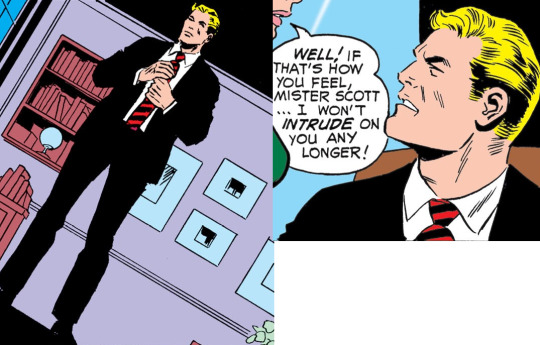
you may be thinking. well, it’s just a black suit. but the fact of the matter is that -- as the entries below will prove -- it used to be that you couldn’t pay alan to wear black so this sharp look takes a particular significance when you know it comes from all-star comics 1976 #64 when gbc goes resolutely bankrupt and the last of alan’s sanity takes a dive out the window. it’s a great suit! a real classic!
9. relaxing at home :)

every other good alan outfit comes immediately before an all out mental breakdown and this one’s no different! direct from comic cavalcade 1942 #19, artist paul reinman gives us a deliciously cozy little outfit: pyjama pants & dressing gown after a hard night of crime-fighting. the ascot just makes it for me!
8. lonesome cowboy

alan’s vacation outfits are famously unbeatable (you’ll see what i mean in just a moment) but this fringe jacket & cowboy hat look from all-american comics 1939 #99 is a real early one and a personal favourite. alan goes on a fishing day trip upstate with streak the wonder dog and makes sure to dress for the occasion!
7. cool & casual

post-bankruptcy and whilst living in jay garrick’s guest room, alan started dressing a lot more casually now that he wasn’t busy playing ceo all day long. i love this look so much, the sports jacket with the turtleneck underneath is simply fantastic and the bright colours are immensely in character. a real winner from green lantern 1960 #109!
6. cool & casual (continued)

i always enjoy alan’s personal style when he’s off the clock and this specific outfit from solomon grundy 2009 #7 feels like a nice little continuation of the above, it denotes a genuine preference for these jackets even if the colour palette is reversed. ranking-wise, places could be switched in either direction with these two but i’m a big fan of the red!
5. something to hide

back in the nineties when alan had regained his youth via the starheart and ended up looking as young as his children, he’d spent most of his time as sentinel and there had been very little seen of him at gbc for various reasons. chase 1998 #8 dares to break that pattern and proposes that when attending events as the head of gotham broadcasting, alan would take certain steps to try and hide his unnatural youth -- note the unnecessary glasses, the never-before-seen slicked back hair. i love the details and boy do i love that manic grin!
4. short shorts

i mean. really. what is there to say? alan’s wearing short shorts while on a cruise with the rest of the gang in justice society of america 1992 #6. it speaks for itself!
3. mr ceo

paul smith’s leyendecker-style alan scott in the golden age 1993 #1 is perhaps the greatest representation of Mr. GBC CEO -- one of the most vital aspects of who alan is as a person. it’s a fantastic outfit, clearly tailored, and in milder tones than he’d generally wear. this one’s all business and up there with the alan designs & looks of all time!
2. cool and collected
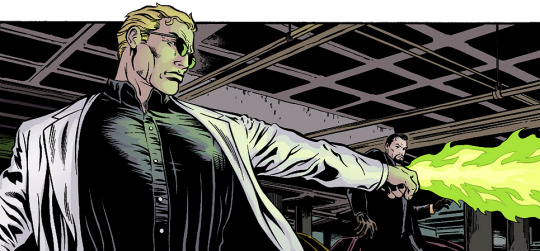
two things alan has never been but this outfit might have you believing otherwise! this is utterly magnificent to me. the sunglasses, the shirt & blazer, the undercover bruce wayne flinching in the background -- it’s all there. detective comics 1937 #786 gives us one of the best off-duty alan looks and i’ll stand by that forever and ever!
1. variations on a theme

at the end of the day, paul reinman’s variations on alan’s every day outfits throughout his run on comic cavalcade 1942 are completely unbeatable to me! the characteristically bright colours, era-appropriate semi-formal looks, the preference for the green suit (his best suit!) sometimes worn with its matching trousers and sometimes not, details like the bracelet in the bottom middle panel or the ever-changing ties... this is the absolute height of alan’s non-lantern outfits!
thank you & goodnight
#alan scott#green lantern#doiby dickles (who is sometimes present)#paul reinman#(who features more than anybody)#u can reblog#NOBODY ASKED FOR THIS BUT I HAD FUN AND THATS WHAT MATTERS#'does alan dress gay' - the greatest thread in the history of the jsa locked by a moderator after 12568 pages of heated debate
13 notes
·
View notes
Photo
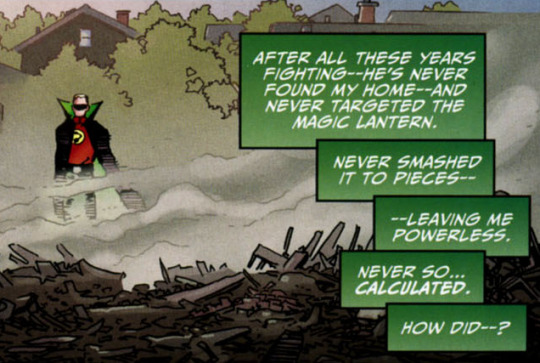


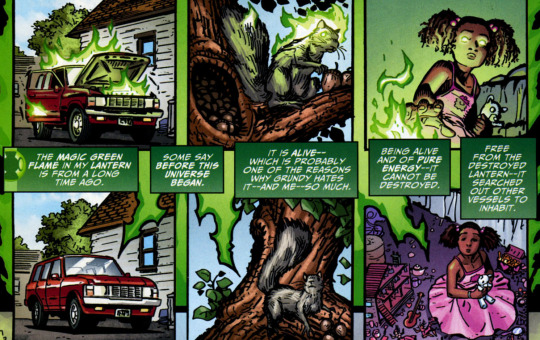
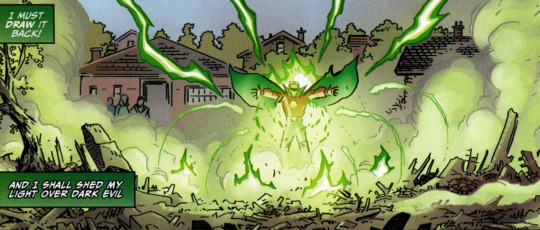
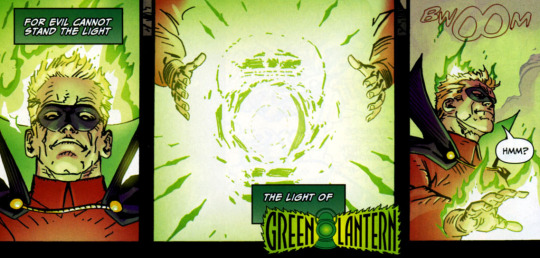
Focus. Concentrate. Breathe. Time to set things right.
Alan Scott in Solomon Grundy (2009) #5
35 notes
·
View notes
Photo

WELCOME TO THE MAYBE-ANNUAL COMIX ROUND-UP EXTRAVAGANZA!
As much as a whole lot of this year has sucked, I’m forever grateful to have found a refuge in comics and to have discovered some really devastatingly good stories out there, most of which have now become what I’d consider all-time favourites. Here’s to getting into Alan Scott and the JSA & co! Without further ado, my top ten COMIX of the year (very few of which are actually recent):
Strange Adventures (2020)
Green Lantern 80th Anniversary 100-Page Super Spectacular (2020) -- “Dark Things Cannot Stand The Light” (Tynion, Frank)
The Golden Age (1993)
The Book of Fate (1997)
JSA (1999)
JSA: Classified (2005)
Superman’s Pal Jimmy Olsen (2019)
Comic Cavalcade (1942)
Green Lantern (1941)
Justice Society of America (1992)
Honorary mentions: Fate (1994), Rorschach (2020), The Spectre (1992), Solomon Grundy (2009), All-Star Squadron (1981) #20, Infinity Inc (1984) #9, DC First: Green Lantern/Green Lantern (2002) #1, All-Star Comics (1976) #60-#69 and Starman (1994) #28.
HAPPY NEW YEAR!!!!!!
#DC#DC COMICS#JSA#IM ONLY TAGGING THEM CAUSE THEYVE GOT THE MOST MENTIONS HERE AND I DONT WANNA SPAM TAGS
4 notes
·
View notes
Text
i love the solomon grundy 2009 eight issue miniseries because alans only mission is to keep cyrus gold alive for one day and he dies in literally every issue
4 notes
·
View notes
Photo

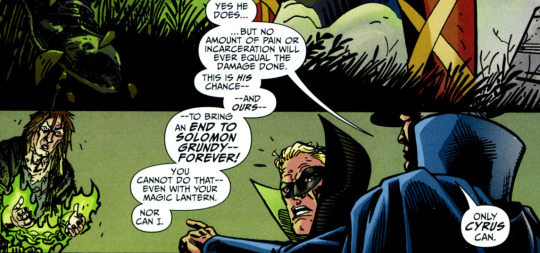



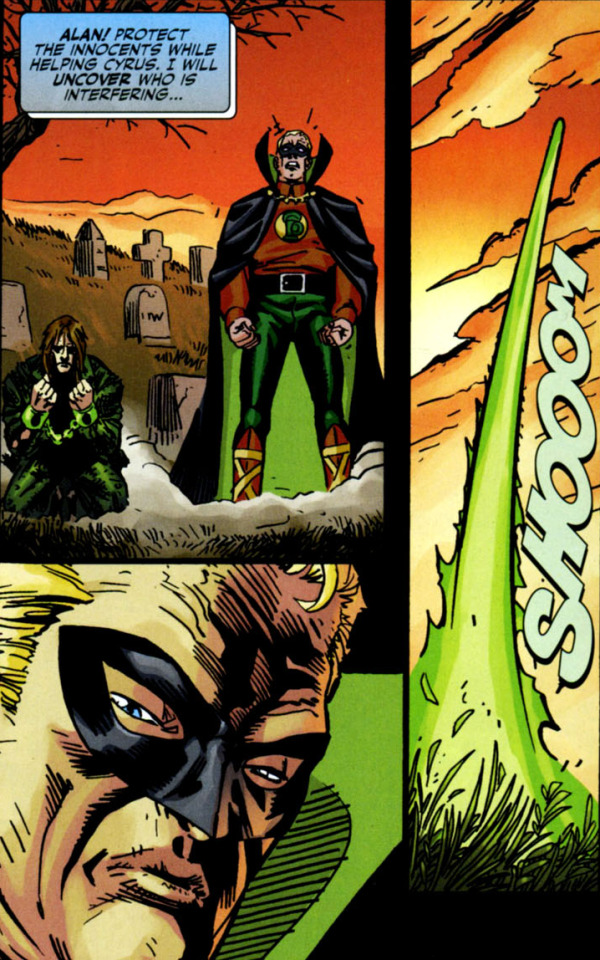

SOLOMON GRUNDY (2009) #1
#ALAN SCOTT#GREEN LANTERN#SOLOMON GRUNDY#PHANTOM STRANGER#DC#U CAN REBLOG#PLEASE THIS IS SO FUCKING FUNNY I CANT STOP LAUGHING#ALAN LOOKS AT HIM LIKE. THEN PERISH#THE FACT THAT STRANGER HAS TO TALK ALAN OUTTA STRAIGHT UP MURDERING CYRUS
4 notes
·
View notes
Photo
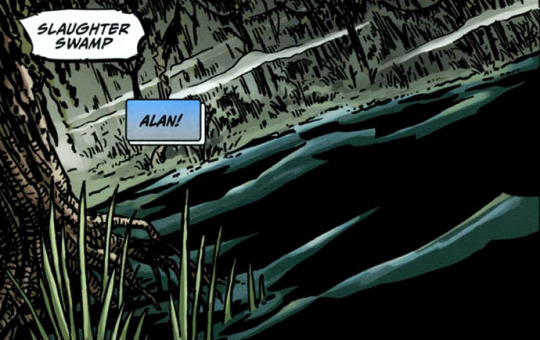

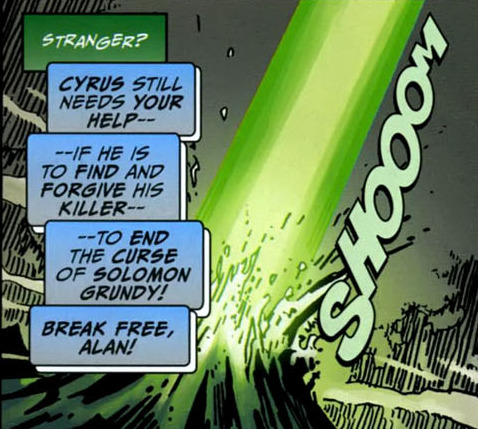
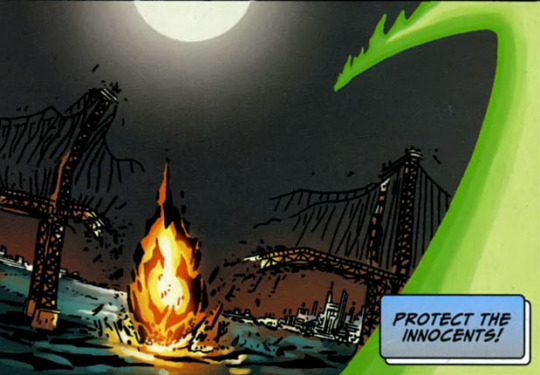


Solomon Grundy (2009) #2
#ALAN SCOTT#GREEN LANTERN#SOLOMON GRUNDY#DC#U CAN REBLOG#GOD THIS FUCKS SO HARD ACTUALLY#FINALLY SOME GOOD ART
3 notes
·
View notes
Photo


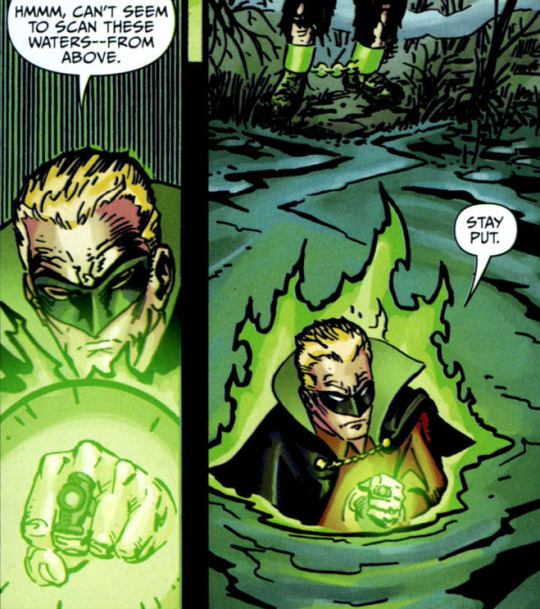


Solomon Grundy (2009) #1
#ALAN SCOTT#GREEN LANTERN#SOLOMON GRUNDY#DC#U CAN REBLOG#YES IM SINCERELY LOSING IT ABT ALAN JUST. WALKING INTO THE WATER#GOD IVE MISSEDDDDD COMICS LIKE THIS#ALSO FOR THE FOLKS AT HOME KEEPING SCORE. YES HE GETS THEM BOTH KILLED BUT THEY RESTART IN THE SAME PLACE BC SLAUGHTER SWAMP
3 notes
·
View notes
Photo
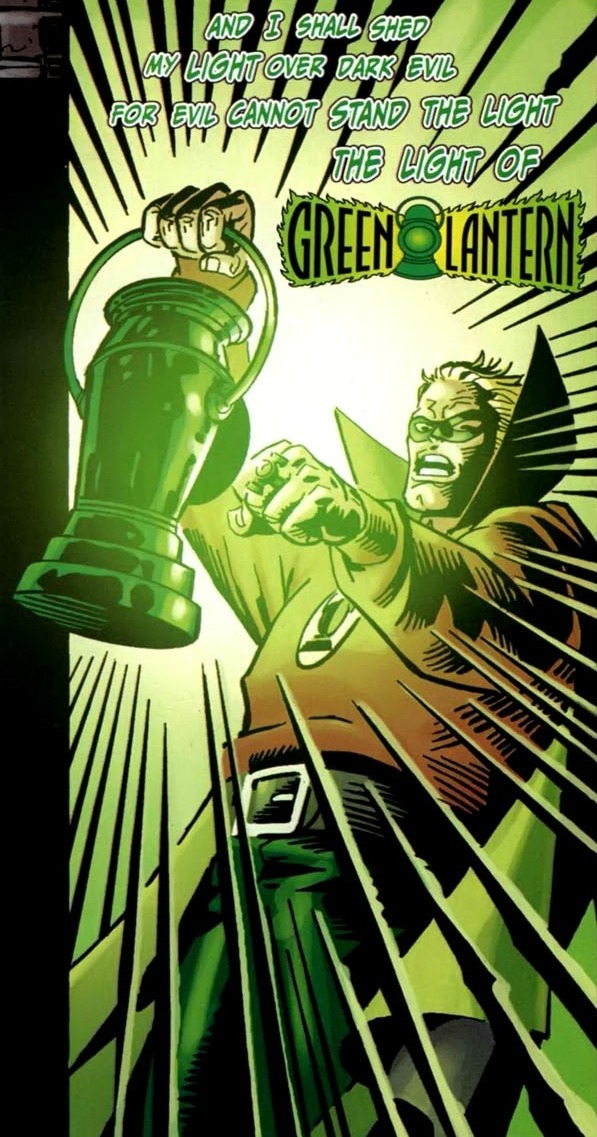
Alan Scott in Solomon Grundy (2009) #3
0 notes